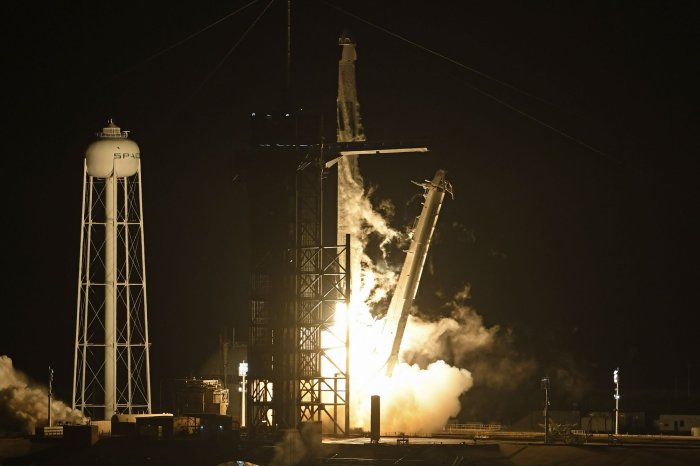1 of 5 | NASA's Crew-3 astronauts perform spacesuit checks ahead of boarding their Dragon capsule to undock from the International Space Station on Thursday. Photo courtesy of NASA
ORLANDO, Fla., May 4 (UPI) -- NASA's Crew-3 astronauts undocked from the International Space Station on Thursday after a six-month stay at the orbital outpost.
Raja Chari, Kayla Barron and Tom Marshburn of NASA, along with Matthias Maurer of Germany, boarded their Dragon spacecraft and closed the hatch at 11:20 p.m. EDT on Wednesday as they prepared for the 23-hour trip back to Earth.
Controllers started the undocking sequence for the Crew Dragon capsule, named Endurance, at 1:16 a.m. EDT Thursday for the flight back to Earth. The capsule was unhooked and backed away from ISS at 1:20 a.m. EDT while ISS was orbiting over Australia.
A splashdown is expected around 12:43 a.m. EDT Friday, according to NASA.
"Weather is being watched closely to confirm selected primary & alternate sites are good for return," Kathy Leuders, associate administrator for NASA's space operations mission directorate, tweeted.
Over the course of the mission, Crew-3 has conducted hundreds of research projects and welcomed two new crews of astronauts -- Crew-4, which launched on April 27 and arrived at ISS about 15 hours later, and the first crew of private astronauts.
Crew-4 -- NASA's Kjell Lindgren, Jessica Watkins and Bob Hines and Samantha Cristoforetti of the European Space Agency -- will stay on the ISS for six months.
Crew-3 astronauts also welcomed the first private group of astronauts to fly to the space station on a commercial spacecraft.
Michael Lopez-Aligria, Larry Conoor, Mark Pathy and Etyan Stibbe were part of Axiom Space's Ax-1 mission.
That journey saw the four civilans spend 16 days at the station, carrying out scientific research before returning to Earth.
To prepare for the journey home, Crew-3 donned their spacesuits and made sure there were no issues ahead of Thursday's undocking, handing off each of the tasks and projects they were working on.
Marshburn then handed command of the space station over to Russia's Oleg Artemyev.
"The lasting legacy of the space station is that it remains the center of international cooperation and a place of peace," Marshburn said. "I know we're leaving the station in good hands with you, Oleg."
"Thank you for your friendship and your leadership," Artemyev said. "It's only been a short time, but on behalf of myself, Denis and Sergey, we've enjoyed our time with you and you are all our brothers and sisters in space."
Crew-3's departure had been delayed 24 hours so that officials could get a better look at the weather expected in the planned splashdown zones.
The capsule, which is fully autonomous, will navigate away from the space station before ground controllers give the go ahead for de-orbit burn.
Endurance will then fire up its thrusters and drop through the atmosphere. As it descends, parachutes will deploy, slowing the craft enough to safely splash down in the ocean off the coast of Florida.
SpaceX and NASA have designated seven potential landing sites, though which one they will opt for depends on the weather and sea states at the time of landing.
Once the crew splashes down, recovery teams will hoist the capsule out of the water and the crew will be extracted and flown via helicopter back to Cape Canaveral.
"100 years from now, we'll be looking back on the ISS not only as an incredible engineering accomplishment, but also on its ability to improve human life," Marshburn said. "We're proud to be a part of that."
The SpaceX Falcon 9 rocket launches NASA's third crew to the International Space Station at 9:03 p.m. November 10 from the Kennedy Space Center in Florida. Photo by Joe Marino/UPI |
License Photo
















